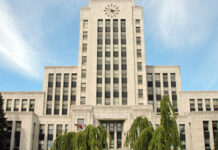
Photo by Sukhwant Singh Dhillon
IN response to Vancouver’s changing population, rising housing costs, and the increased need for diverse types of housing, the City of Vancouver on Thursday announced that it will advance the transformation of single-family neighbourhoods by increasing the variety of homes available for families, renters and seniors.
The City’s new Housing Vancouver strategy sets out to provide Vancouver residents with the right supply of housing, and to encourage communities where families can reside. Census data released this year showed a decline in overall population and children in neighbourhoods like Dunbar, Kerrisdale and Arbutus Ridge. The goal of 10,000 new ground-level homes such as townhouses, rowhouses and infills will be developed in single-family neighbourhoods across Vancouver over the next 10 years, as part of an overall goal of 72,000 new homes in Vancouver over the next 10 years.
“With the new Housing Vancouver strategy, we can transform low-density neighbourhoods across the city by increasing the supply, affordability and variety of housing options, such as townhouses and rowhouses,” said Vancouver Mayor Gregor Robertson. “We’ve heard loud and clear that Vancouverites expect us to address the fact that vast areas of low-density neighbourhoods are unaffordable for all but the very wealthy – with many of them seeing a decline in families and kids. With the new Housing Vancouver strategy, we can transform our low-density, single-family neighbourhoods with more duplexes and triplexes, more townhouses and rowhouses, and more low-rise apartments – and make sure every neighbourhood across Vancouver is filled with families and kids.”
Housing Vancouver includes a comprehensive strategy to reduce speculation in real estate, as well as implementing initiatives like the Empty Homes Tax, regulating short-term rentals, and continued advocacy for a provincial speculation tax.
A new Tactical Response Team will review city-wide regulations to implement zoning changes starting in 2018, such as allowing multiple homes to be built on a single lot including duplexes, triplexes, and fourplexes, with multiple suites.
“Housing and affordability must reflect the diversity of our residents and support those most in need of housing,” says Gil Kelley, General Manager, Planning, Urban Design and Sustainability. “Our Housing Vancouver strategy lays the groundwork for change in our city to increase the variety of housing options – the right homes Vancouver residents need and can afford.”
To expand housing options in low-density neighbourhoods, the City will launch a design competition to create a new form of housing to accommodate more housing than the current limit of three units on a single-family lot.
A laneway design competition will launch in early 2018 and conclude in the fall. The competition will explore innovative, creative designs and affordability for new infill housing to help meet the City’s targets of 5,000 new laneway and coach homes over the next ten years.
To create more homes in single-family neighbourhoods, next steps by the City include:
* Identifying areas close to parks, schools, public amenities and main streets for new townhomes and low-rise apartment developments
* Expanding more affordable housing options in communities by initiating planning around shopping areas and neighbourhood centres
* Providing more family housing options by exploring and promoting apartment developments with townhouses with front doors on the ground floor
* Investigating regulatory changes and further incentives for diverse new developments through parking reductions and car sharing
Transformation of low-density neighbourhoods to provide more family and rental homes is already underway for the Oakridge Municipal Town Centre as part of the Cambie Corridor Phase 3 Planning. The plan increases family housing and rental options, adds job space, and creates better access to transit and public amenities for more residents in a more complete, vibrant community. Phase 3, which focuses on the low-density residential areas off Cambie Street, is anticipated to add 10,000 new homes by 2041, including a significant amount of rental housing and townhomes. This is complemented by additional housing and job space on Cambie and major streets guided by the Phase 2 Cambie Corridor plan.
“Small Housing BC and Smallworks are avid supporters of the City of Vancouver’s latest housing strategy and three-year action plan. Through this strategy and plan, we see significant opportunity to meet the diverse housing needs of the residents of Vancouver. We feel a number of initiatives within the action plan are focused on key issues. This includes an evolution of our neighbourhoods with a varied stock of ground-oriented housing, and the need to provide smaller scale family homes by creating infill that addresses the following: long-term affordability and the negative impacts of speculation in single-family areas. As such, the action plan’s proposed approach offers a significant opportunity to create more dynamic communities that can preserve the feel of our neighbourhoods while facilitating a community of greater accessibility for homeownership and vibrancy,” said Jake Fry, Founder and Principle, Smallworks Studios and Laneway Housing Inc. and Board Member of Small Housing BC.
For more information, visit vancouver.ca/housing
<http://












